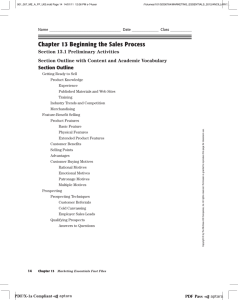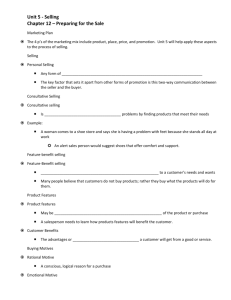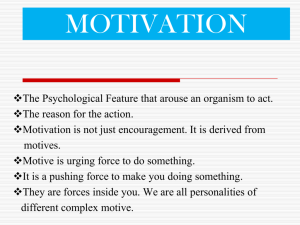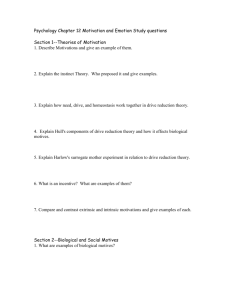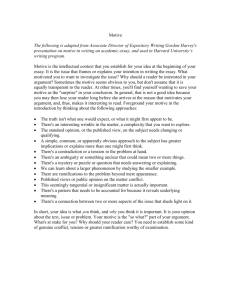ppt2
advertisement
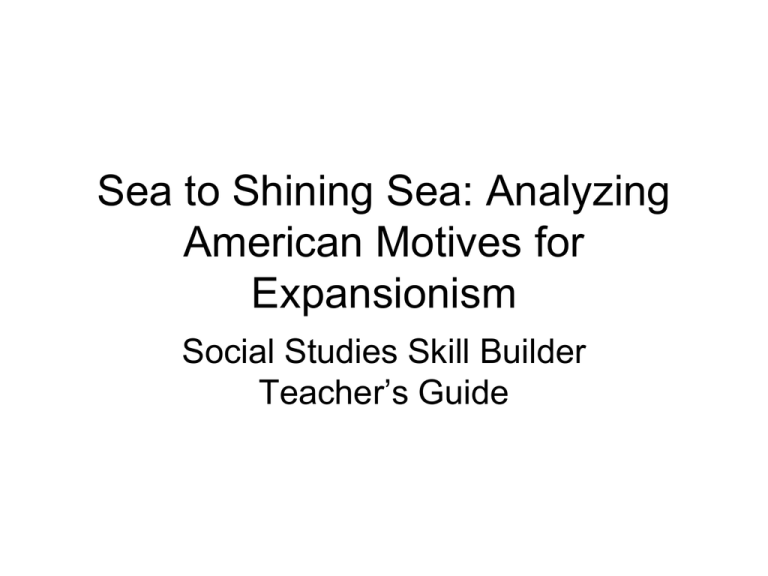
Sea to Shining Sea: Analyzing American Motives for Expansionism Social Studies Skill Builder Teacher’s Guide Overview This Social Studies Skill Builder allows students to understand the motives behind the American rush to fulfill their Manifest Destiny in the 19th Century. Students are introduced to five different types of motives—political, economic, exploratory, religious, and ideological. The students will be given time to examine the written and visual artifacts—such as a painting of the Massacre at Wounded Knee and an image of silver mining in the West—to analyze which motives for expansion each artifact reveals. Students will work in pairs and describe what they see in the placard, draw the symbol for each motive shown, and then write a brief explanation of why they chose the motive they did. Afterward, students will see the results of the motives for expansion as they examine the slide mapping United States expansion to 1899. Preview Before you begin the lesson, have students write a paragraph explaining in detail a moment or event in their life where they ended up regretting the result of their actions. Since this is a personal memory, also have students explain in the paragraph some reasons why they acted as they did in that particular instance, moment, or event. After students are done writing, have volunteers share their memory and reasons why they feel they acted the way they did. End the preview by explaining that reasons for behaviors are called motives. Finally, explain that in the lesson students will understand the motives behind the American rush to fulfill their Manifest Destiny in the 19th Century. Before Class Print out/color copy (on card stock) Slides 2-17 on the Sea to Shining Sea Slide Presentation. Make student copies of Slides 2-4 on the Sea to Shining Sea Teacher Guide. Procedures 1. Divide your students into mixed-ability pairs. Explain that students will be analyzing up to 15 written and visual artifacts depicting American motives for expansionism in the19th Century. 2. Pass out Student Handout (Slides 2-4 on the Sea to Shining Sea Teacher Guide) and introduce students to the five major categories of expansionist motives. Have them design a symbol to represent each motive. Explain that some motives have similar elements and thus when students examine the artifacts they will likely see more than one motive reflected. 3. Show students Presentation Slide 3 of the Sea to Shining Sea Slide Presentation, and explain that this is what the United States looked like in 1853 (before the Civil War). Answer any questions students may have. 4. Give each pair a placard (Slides 2-17 Sea to Shining Sea Slide Presentation). Tell the pairs to examine the artifact on the placard and to carefully fill in the cells on their handout (describing what they see, drawing the appropriate symbols), and explain their choice for the motives they choose). Be sure to model the type of responses you would like to see. 6. At the end of the activity, tell pairs that the last placard they completed will be the one they present to class. Project slides from presentation. Have pairs come forward before the class. After you describe to the class what the image represents, have pairs describe their symbol and give a brief summary or the reasoning. Audience should be filling their charts as presenters give their information. Repeat for remaining slides. Wrap Up Project Slide 18 from the Sea to Shining Sea Slide Presentation, which shows a map of the United States until 1853. Then show students Slide 19, a map of the United States at 1899, when states have been added to the Union. Have students examine the slide and respond to the following questions: What do you see in this map? How was the non-American world affected by American expansionism? Which area appeared to be greatest asset to American expansionism? Smallest? What might have been the result of government disinterest in not possessing the areas shown on the map? Explain that the map shows the result of American expansionism. Read the following excerpt out loud to the class. Though American expansionism dates back to the very first colonists at Jamestown, the rapid drive for territory led Americans on the path to try and gain political control of what is now called the lower forty-eight states. Between 1853 and 1899, the U.S. government scrambled to finish inhabiting the lands west of the Mississippi River. Once the West was claimed and national borders were established, the first step to statehood meant—among other things—establishing territories, installing infrastructure, and resolving the issue associated with the displacement of Native Americans. American expansionism brought technologies and industrialization. But to Native Americans, expansionism represented a profoundly disruptive assault. The U.S. government relied on force to conquer and rule, and treated the Native Americans as racial inferiors until they accepted the Anglo way of life. Further domination often destroyed traditional economies and culture. By the early 1900’s, territorial leaders in the Arizona, New Mexico, and Oklahoma territories began organizing measures for statehood and officially joined the Union. Processing Assignment Have students make a spectrum that ranges from “Most Praiseworthy Motive” to Least Praiseworthy Motive.” Have students work in groups of four to discuss to what extent each of the five motives was praiseworthy. Afterward, have students record their responses—which may differ from that of their group peers—on the spectrum, and include a onesentence justification for each placement. Expect student responses to vary. Encourage students to use the evidence they have recorded from the lesson. Guide to Slides 2-17 Slide 2: Photograph of miners working at Little Giant mine in Pony Gulch, Colorado, 1900. Expansionist motive students might see is economic (miners mining for minerals like gold and silver made individuals rich and was a primary reason for the first westward migrations). Slide 4: Photograph of Charles Rath, a famous buffalo hunter, seated on a “rick” of Expansionist motive students might see is economic (Demand for food became greater as the West was colonized. New army posts, railroad workers, and construction men had to be fed, so local men were contracted to supply buffalo meat. People back east were demanding buffalo robes that they used as coats and lap robes when riding in sleighs and carriages). Slide 5: Newspaper advertisement for a sale of Indian land, 1911. Expansionist motive students might see is economic (Native American land was confiscated and used as incentive for railroad companies to lay track and for homesteaders, ranchers, and prospectors to inhabit and work the new land). Slide 6: Map of early western migration in the United States, 1858. Expansionist motive students might see exploratory (maps marked established routes and hazards for Americans heading west and became an invaluable resource to American expansionism). Slide 7: Painting of the Massacre at Wounded Knee, 1890. Expansionist motive students might see is political (the massacre was accidental, but the motive of the U.S. government to temporarily move the Sioux to Wounded Knee Creek was to disarm the band and use a display of force coupled with firm negotiations to gain compliance before moving the remaining to a reservation in Nebraska). Slide 8: Photograph the ceremony for the driving of the "Last Spike" signifying the joining of the tracked Central Pacific and Union Pacific Railroad grades at Promontory Summit, Utah. 1869. Expansionist motive students might see are economic (the transcontinental railroad opened up—among other things—financial opportunity for Americans), political (the transcontinental railroad was a government endeavor to connect the east and west by rail), and ideological (the transcontinental railroad represented progressive change to the west that became the mantra for American expansionism). Slide 9: United States’ map of overland expedition to the Pacific Coast and back by Meriwether Lewis and William Clark, 1806. Expansionist motive students might see are political (map was the first charted government sponsored expedition westward) and exploratory (areas west of the Mississippi River were relatively unknown in this time). Slide 10: Before and after photograph of Navaho Tom Torlino at the Carlisle Indian School, 1885. Expansionist motive students might see is ideological (Tom Torlino has been forced to give up his native way of life in favor of a white way of life). Slide 11: Photograph Allen Street in Tombstone, Arizona Territory, 1882. Expansionist motive students might see is ideological (before settlement the West was primitive and settlements such as Allen Street brought civilization westward). Slide 12: Quote from Samuel Allis regarding the conversion of Pawnee Indians in Kansas, 1837. Expansionist motive students might see are religious (conversion to Christianity was a major step in conquering the West ) and ideological (American values are based on Judeo-Christian principles). Slide 14: Photograph of Mormon pioneers on Little Mountain, 1847. Expansionist motive students might see are religious (Mormons migrated west due to often being harshly treated and persecuted for their religious beliefs ) and exploratory (blazed new 40,000 Buffalo hides in Robert Wright's Dodge City (Kansas) hide yard, 1878. trail to Great Salt Lake Basin off of Bozeman trail) . Slide 15: John Gast’s painting “American Progress, 1872. Expansionist motive students might see are political (shows nation’s determination to expand with telegraph wires being strewn) and exploratory (though in control of much of the West, most was still unearthed territory and would continue to be until 1890). Slide 16: Surrender Speech by Chief Joseph of the Nez Perce, 1877. Expansionist motive students might see are political (military might shown in surrender of Nez Perce, a once valiant foe) and ideological (America showed its superiority and survivability with native surrender). Analyzing American Motives ECONOMIC motives included the desire to make money, to expand and control trade, to create new markets for products, to acquire raw materials and cheap labor, to compete for investments and resources, and to export industrial technology and transportation methods. Your Symbol EXPLORATORY motives were based on the desire to explore "unknown" or unearthed territory, to conduct scientific research, to conduct medical searches for the causes and treatment of diseases, to go on an adventure, and to investigate "unknown" lands and cultures. Your Symbol POLITICAL motives were based on a nation's desire to gain power, to compete with other countries, to expand territory, to exercise military force, to gain prestige by winning colonies, and to boost national pride an security. Your Symbol Your Symbol RELIGIOUS motives included the desire to spread Christianity, to protect American missionaries in other parts of the country, to spread American values and moral beliefs, and to educate peoples of other cultures. Your Symbol IDEOLOGICAL motives were based on cultural values: the belief that the white race was superior, other cultures were "primitive", Americans should "civilize" peoples in other parts of the world, great nations should have empires, and only the strongest nations would survive. Sea to Shining Sea: Analyzing American Motives for Expansionism Social Studies Skill Builder Preview Write a paragraph (5 sentences) explaining in detail a moment or event in your life where you ended up regretting the result of your actions. Since this is a personal memory, explain in the paragraph some reasons why you acted as you did in that particular instance, moment, or event. U.S. Map in 1865 Before and after Assimilation Navaho Tom Torlino in 1882 (left) as he arrived at the Carlisle Indian School. Tom Torlino (right) in 1885. "There are so many difficulties and hinderances at present, among [the] Indians, the prospect of introducing Christianity among them at present is rather discouraging ... it is a mistaken idea that many Christians have at the present time, thinking that nations of Indians are to be born to God in a day ... I believe that many years will pass first." Samuel Allis, 1837, regarding the conversion of Pawnee Indians in Kansas The Whitman Massacre One hundred and fifty years ago the mission established by Marcus and Narcissa Whitman near present-day Walla Walla, Washington was a way station for overland immigrants to Oregon. An outbreak of measles in 1847 ravaged the Cayuse tribe which lived near the mission. Although Doctor Whitman gave medicines to the Indians the number of fatalities among the tribe continued to grow. On November 29, 1847 the mission was attacked by the Cayuse and Doctor Whitman, his wife Narcissa, and twelve other whites were killed. John Gast’s "American Progress" (1872) America floats westward through the air with the “star of the empire” on her forehead. She has left the cities of the East behind, and the wide Mississippi River, and still her course is westward. In her right hand, she carries a school-book, and in her left she tenders telegraph wires that will bind the nation together. Fleeing her approach are Native Americans, buffalo, wild horses, bears, and other game disappearing into the storm and waves of the Pacific coast. Surrender Speech by Chief Joseph of the Nez Perce I am tired of fighting. Our chiefs are killed. Looking Glass is dead. Toohulhulsote is dead. The old men are all dead. It is the young men who say yes or no. He who led the young men is dead. It is cold and we have no blankets. The little children are freezing to death. My people, some of them, have run away to the hills and have no blankets, no food. No one knows where they are--perhaps freezing to death. I want to have time to look for my children and see how many I can find. Maybe I shall find them among the dead. Hear me, my chiefs. I am tired. My heart is sick and sad. From where the sun now stands, I will fight no more forever. Joseph was chief of the Nez Perce, a Native American tribe of the Wallowa Valley in Northwest Oregon. In 1877 the Nez Pierce were ordered to a reservation, or special land reserved for Native Americans. The Nez Pierce refused to go. Instead, Chief Joseph tried to lead 800 of his people to Canada. Fighting the U.S. Army all along their 1100 mile journey, they crossed Idaho and Montana. They were trapped just forty miles from Canada. After a five-day fight, the remaining 431 remaining Nez Perce were beaten. It was then, on October 5, 1877 at Bears Paw, that Chief Joseph made his speech of surrender. U.S. Map in 1865 Statehood Date Map Processing Assignment 1. Make a spectrum that ranges from “Most Praiseworthy Motive” to Least Praiseworthy Motive.” 2. Work in groups of four to discuss to what extent each of the five motives was praiseworthy. 3. Record responses—which may differ from that of group peers—on the spectrum, and include a one-sentence justification for each placement. 4. Use the evidence recorded from lesson.
